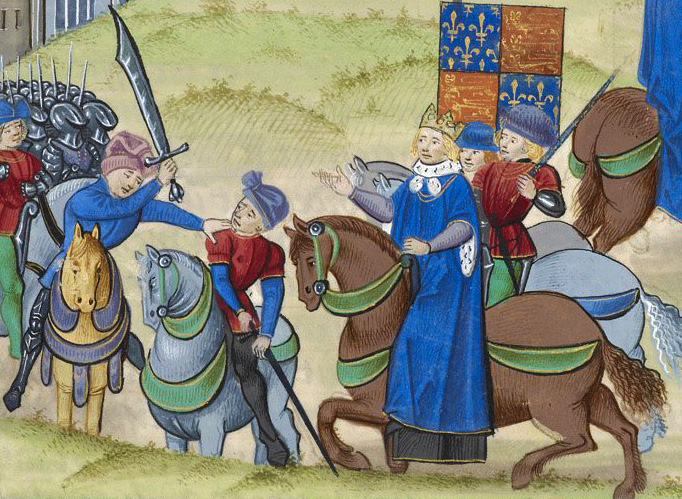Wat Tyler

Walter "Wat" Tyler (January 4, 1341 – June 15, 1381) was the leader of the English Peasants' Revolt of 1381.
Early life
Knowledge of Tyler's early life is very limited, and derives mostly through the records of his enemies. Historians believe he was born in Essex, but are not sure why he crossed the Thames Estuary to Kent. Local tradition in Brenchley was that he was born there.[1]
The Peasants' Revolt
With news of rebellions of the upper classes in France and Flanders, the English readied for an insurrection. John Ball, Jack Straw and others advocated the destruction of the hierarchical feudal system. Ball, like Tyler, held egalitarian values, though the medieval historian Jean Froissart describes Ball as insane. Other contemporaries suggest that he was involved with the Lollard movement. Such harsh, often unfounded attitudes toward the rebels are common among chroniclers as they belonged to the educated upper classes, usually the targets of rebellion and not supporters of it. Thus, it is difficult to get an accurate sense of the actual aims and goals of rebels as their side of the story is not represented in historical accounts. However his name does appear in many monk scripts that were discovered throughout the years.
Richard II ascended to power after the death of Edward III; he was only 14 at the time of the rebellion. Since he was a minor, the Dukes of Lancaster, York, and Gloucester governed in his name. These officials were the main targets of the rebels, who held that they were traitors to the king and undermined his authority. Several unsuccessful expeditions against France added to the burden on the English working class. The government resolved on a poll tax of three groats, which outraged the people because it was the same for rich and poor.
Reacting to the introduction of the oppressive poll tax, which the king had imposed because not enough income had been collected the previous year, Tyler led a force of peasants in taking Canterbury, before advancing on to Blackheath, outside London. Tyler then entered the city of London at the head of a peasant army estimated at numbering over 50,000 men. After crossing London Bridge without resistance, the rebels then gained entry to the Tower of London and captured Simon Sudbury, the unpopular Archbishop of Canterbury, before proceeding to behead him and several of his followers. The rebels also destroyed the Savoy palace during subsequent rioting and killed the king's uncle. Richard of Wallingford presented a charter to King Richard II on behalf of Tyler. The king met the rebel army at Mile End and promised to address the peasants' grievances, which included the unpopular taxes.
Twenty thousand people assembled at Smithfield. Richard II agreed to meet the leaders of the revolt, and listen to their demands. Wat Tyler decided to ride out alone and parley with the King. What was said between Wat Tyler and the King is largely conjecture and little is known of the exact details of the encounter; however, according to one popular account it would appear that the Lord Mayor of London, Sir William Walworth, took exception to Wat's attitude, because the Mayor quickly drew his sword, and slashed the unarmed Wat Tyler to the ground. In the next instant, the body was stabbed by one of the King's esquires, John Cavendish.
References
- ^ Archaeologica Cantiana. Canterbury: Kent Archaeological Society. 1880. p. 139.
- Froissart, Jean, Froissart's Chronicles, New York, J. Winchester, pp. 283–290.
- Life and Adventures of Wat Tyler, the Brave and Good, London, Collins Publishing, 1851.
- "Historical, Biography of Wat Tyler", New York Daily Times, October 28, 1852, page 3.
- Hanawalt, Barbara A. The Middle Ages, New York, Oxford University Press, 1998, page 139.
- Robinson, John J. Born in Blood: The lost secrets of Freemasonry New York, M. Evans and Company, Inc., 1989.
See also
- John Ball – co-leader of 1381 Peasants' Revolt
- Jack Straw – co-leader of 1381 Peasants' Revolt
- Jack Cade – leader of 1450 Kentish Revolt
- Robert Kett – leader of 1549 Norfolk Rebellion
- Bartholomew Steer – leader of 1596 Oxfordshire Rebellion
External links
- Wat Tyler Country Park
- Wat Tyler on historyguide.org — a description, from a chronicle of the time, which relates the final meeting between Wat Tyler and King Richard II.
- EASF radical history wiki An East Anglia-specific look at the rebellion
